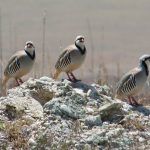Prairie Grouse and Huns 2018 Traveling Wingshooter
The big news for prairie grouse is the breaking of the drought in the northern Great Plains. The drought resulted in lower populations coming into the spring of 2018, but the weather has been favorable from Kansas all the way to northeastern Montana.
In South Dakota, habitat conditions for prairie grouse looked amazing throughout May, June, and July, said Runia. He cautioned that reproduction may be somewhat suppressed by lack of residual cover following the drought, and unknown impacts from the historic cold April. Nevertheless, sharptails and prairie chickens will clearly be on the rise in SoDak.
Gross offered a similar take for North Dakota, noting that last summer’s brood surveys revealed a 40-percent decline from 2016 to 2017, but the weather this spring and summer was excellent for production of grouse and Huns statewide. “We had a good winter, and the birds came into the spring in better body condition. We had nice rains that delayed the haying a bit. Habitat conditions look really good, so I think we’ll be pleasantly surprised.”
In Montana, sharptail and Hun numbers will also clearly be better than last year, but Doggett says it could be spotty depending upon rainfall and spring temperatures. Recently released lek counts saw a decline of 18 percent, and Ken Plourde, Montana Fish, Wildlife & Parks, expects only average populations of sharptails and Huns this year due to the reduced number of adult birds coming into the breeding season. Greater prairie chickens were trending down this spring in all regions of Kansas except the northwest; Prendergast still recommends the Smoky Hills as the best region. Finally, according to Knetter, southwest Idaho looks great for Huns!
E-Blast Updates: October 2018
Prairie grouse hunters that normally focus on the northern Great Plains might consider shifting southward to Nebraska and Kansas this year. In Nebraska, sharp-tailed grouse and greater prairie chicken numbers were up in the Sandhills and Central regions, the portions of the state that offer the best prairie grouse hunting. Habitat conditions in the Sandhills were spectacular with abundant vegetation and lots of insects for good nesting and brood survival. Likewise, greater prairie chicken populations are stable to increasing in the Smoky Hills and Northern High Plains regions of Kansas.
The bad news comes from the heart of prairie grouse country – the Dakotas and Montana – where sharptail population levels are depressed due to the lingering effects of the horrendous 2017 drought. In North Dakota, this summer’s roadside surveys showed a 49-percent decline in statewide grouse numbers from last year. In Montana, lek counts were 25-40 percent below the long-term average and summer moisture was spotty, so numbers are expected to be low again this fall. However, South Dakota should see an uptick due to excellent moisture and habitat conditions across the northern and central regions. This year will be average at best, coming off a tough season when hunters harvested 22,153 prairie grouse, less than half of the roughly 50,000 taken in 2015.
The outlook for Huns is best on the western edge of their range. Biologists in eastern Oregon and southwest Idaho were giddy about the partridge production, even in some areas that are generally marginal for Huns!





